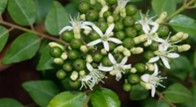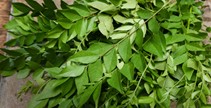Contribute
| Know The Health Benefits Of Kadi Patta (Curry Leaves) |
Madhumati Tyagi and Geetha Patil
11/03/2023
Kadi Patta/Curry Leaves (Murraya Koenigil) are well known for adding exotic aromatic flavor and distinctive taste to Indian cuisine along with their countless nutritional and medicinal benefits. According to Ayurveda, our meals should contain pungent, bitter and astringent ingredients. Kadi Patta, therefore is a perfect ingredient that goes well with dals, Sabjis, curries, vegetable salads, rice dishes, buttermilk, curd, soups, stews, chutneys, seasoning blends, like curry powder, and more. It can be eaten raw. Fried, and cooked. It is called Kadi Patta or Meetha Neem in Hindi, Surabhinimba in Sanskrit, Narasingha in Asamiya, Barsanga in Bengali, Gorenimb in Gujrati, Kadhilimb in Marathi, Karibevu in Kannada, Karepaku in Telugu, Bhursanga in Oriya, Kariveppilai in Tamil, or Karivempu in Malayalam as this tree is indigenous to India, Srilanka, Bangladesh, and many Southeast Asian countries. Curry leaves trees usually grow in the tropical and subtropical climates. These curry leaves add slightly citrusy and bitter flavor to various dishes. They are often used in the tempering process, where they are fried in oil along with other spices to release their flavors before being added to a dish. Since curry leaves, roots, fruits and barks are rich in disease-fighting constituents have been used as Ayurvedic remedies for curing many diseases and ailments for centuries. What are the qualities of curry leaves? Rasa (taste) - Astringent, bitter and sweet; Vipaka (Taste after digestion) - Katu (Pungent); Guna (Qualities) – Laghu (light to digest), Snigdha (Unctous); Virya (Potency) – Shita (Cold); Karma (Action) – Ruchya (Improves taste), Deepana (Kindles digestive fire), Pachana (Improves digestion), Vishagna (Antitoxic), Varnya (Improves complexion); Kaphapittahara – Balances Kapha and Pitta dosha. What are the nutritional values of curry leaves? These small, glossy and dark green curry leaves are powerhouses of various nutrients such as copper, minerals, calcium, potassium, phosphorous, fiber, carbohydrates, vitamin A, C, B-6, magnesium, amino acids, and iron. These curry leaves offer a myriad of health-promoting properties as well. What are the health benefits of curry leaves? Curry leaves are not only a flavorful addition to various dishes, but also offer several potential health benefits due to their nutritional profile and bioactive compounds. 1) Lowers Cholesterol Level: The antioxidants properties of curry leaves in its extraction form help to lower one’s blood cholesterol levels by preventing cholesterol oxidation that produces LDL cholesterol (bad cholesterol), raises the amount of good cholesterol (HDL), and protects from atherosclerosis and heart disease. 2) Boosts Digestion: According to Ayurveda, Kadi Patta has mild laxative properties that not only help the stomach to eliminate waste (constipation and diarrhea) from the system, but also clears the body of 'Ama' (toxic waste) and balances out the pitta levels in the body and stimulates secretion of digestive enzymes and improves overall gut health. Traditionally, the leaves are boiled in water and then consumed. 3) Liver protection: The antioxidants and the strong hepato-protective effects in curry leaves may help protect the liver from damage caused by toxins and oxidative stress. When combined with vitamin A and vitamin C, its highly powerful anti-oxidative property not only prevent but also activates the organ to function more effectively. 5) Hasten hair growth and maintain skin health: Curry leaves are rich in vitamin A, C and iron, which are essential for maintaining healthy hair and skin and treat skin pigmentation. So its extract successfully treat damaged hair, add bounce to limp hair, reinforce thin hair, and falling hair. In addition, it can cure fungal scalp infection of Malassezia furfur and dandruff. a) A paste of Curry leaves or oil are beneficial for hair as its application helps maintain the natural color of the hair. b) Boil fresh curry leaves with coconut oil until they are reduced to a black residue. Then used that as a hair tonic for improving growth and retaining a healthy tone.
by Madhumati Tyagi and Geetha Patil



4) Blood sugar regulation: Some studies suggest that curry leaves may help regulate blood sugar levels and improve insulin sensitivity, potentially benefiting people with diabetes or prediabetes.
6) Promote eye health: The deficiency of vitamin A can cause eye disorders, including night blindness, vision loss, and cloud formation. Curry leaves are rich in carotenoid-containing vitamin A, thereby reduce the possibility of damage to the cornea and protect against loss of vision.
7) Eradicate bacteria: Carbazole alkaloids compounds that contain antioxidant, antibacterial, and anti-inflammatory properties in curry leaves destroys bacteria and cell-damaging free radicals. In Ayurvedic medicine, curry leaves have been used to treat fresh cuts and itching.
8) Promote Weight Loss: Studies show that curry leaves can help reduce the number of triglycerides and cholesterol, which helps to prevent obesity and promotes weight loss.
9) Antioxidant Properties: Curry leaves contain antioxidants, such as phenols and flavonoids, which help protect the body from free radical damage and oxidative stress, thereby possibly reduce the risk of chronic diseases.
10) Anti-Inflammatory Effects: Curry leaves possess anti-inflammatory properties, which help reduce inflammation in the body and alleviate related conditions.
What are the other uses of curry leases?
In diarrhea, green curry leaves are eaten raw.
In morning sickness, curry leaves are used along with lime juice.
Curry leaves paste used to treat boils.
Root juice of curry leaves plant is used to relieve renal boils.
Roots and bark of curry leaves plant are used to treat poisonous animals/insets bites.
Curry leaves infusion is used to treat vomiting.
Curry leaves paste and buttermilk is taken with empty stomach to cure stomach upset.
Fresh curry leaves juice can be used to prevent development of cataract.
Curry leaves are best for blood purification and ideal natural calcium supplement.
You may also access this article through our web-site http://www.lokvani.com/


